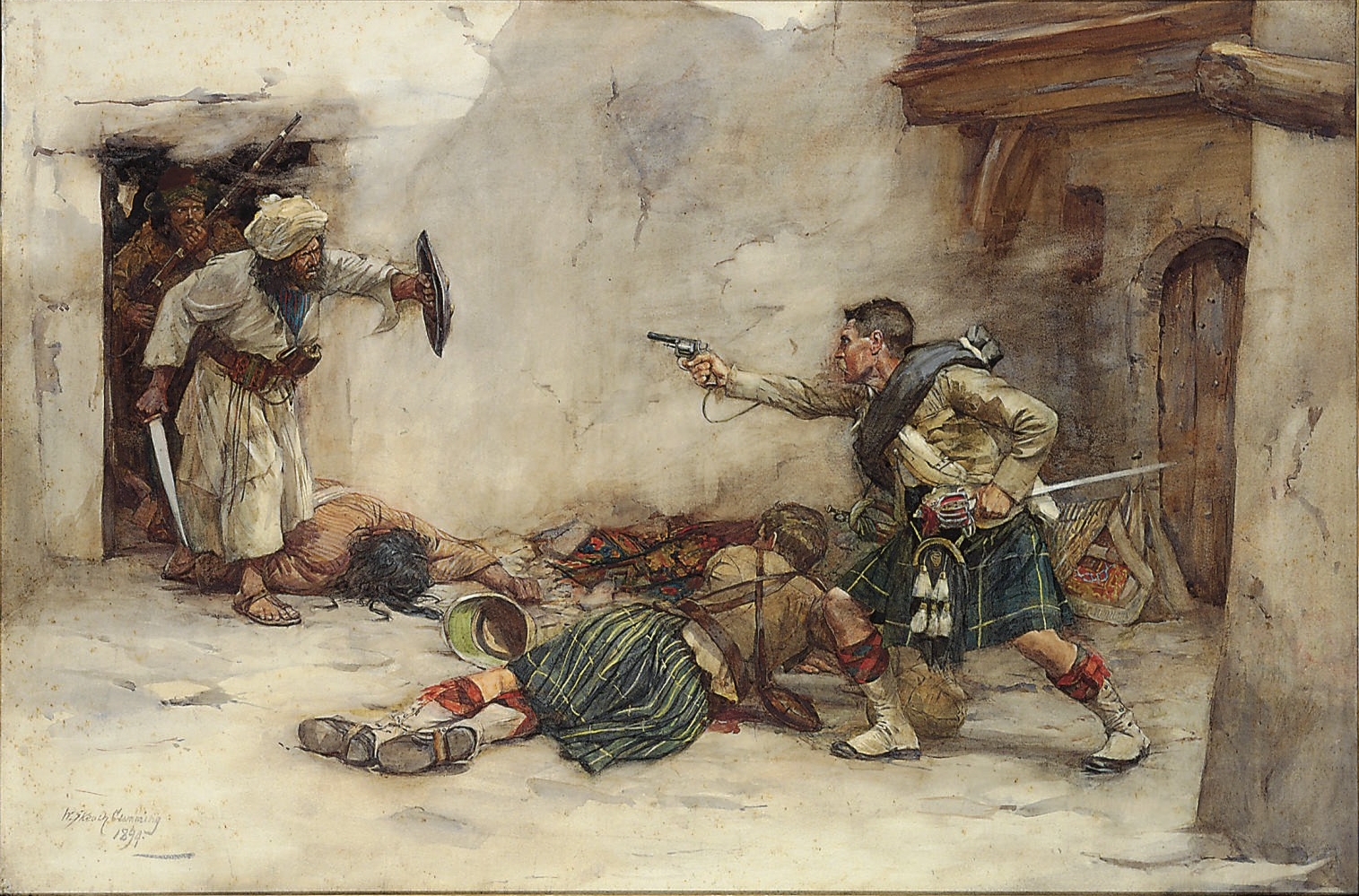William Skeoch Cumming on:
[Wikipedia]
[Google]
[Amazon]



 William Skeoch Cumming (28 December 1864
William Skeoch Cumming (28 December 1864



Edinburgh
Edinburgh ( ; gd, Dùn Èideann ) is the capital city of Scotland and one of its 32 Council areas of Scotland, council areas. Historically part of the county of Midlothian (interchangeably Edinburghshire before 1921), it is located in Lothian ...
– 10 April 1929 Edinburgh), was a Scottish watercolourist, mainly of portraits, military subjects and Scottish Military History. Between 1912 and his death, he turned his hand to the designing and production of four large tapestries.
Life
He was the fourth son of John Cumming (1824–1908), also an artist, and Jane Skeoch, who was a cousin ofHoratio McCulloch
Horatio McCulloch (November 1805 – 24 June 1867), sometimes written MacCulloch or M'Culloch, was a Scottish landscape painter.
Life
He was born in Glasgow in November 1805 the son of Alexander McCulloch, a cotton merchant, and his wife, Ma ...
. William enjoyed sketching exercises with his father before studies at the Edinburgh School of Art
Edinburgh College of Art (ECA) is one of eleven schools in the College of Arts, Humanities and Social Sciences at the University of Edinburgh. Tracing its history back to 1760, it provides higher education in art and design, architecture, histor ...
and the Royal Scottish Academy
The Royal Scottish Academy (RSA) is the country’s national academy of art. It promotes contemporary Scottish art.
The Academy was founded in 1826 by eleven artists meeting in Edinburgh. Originally named the Scottish Academy, it became the ...
School, and began his art career at the Theatre Royal as a scene painter. His sketches on Scottish life appeared in the Black & White magazine of 1896.
He served with the 19th Company Imperial Yeomanry
The Imperial Yeomanry was a volunteer mounted force of the British Army that mainly saw action during the Second Boer War. Created on 2 January 1900, the force was initially recruited from the middle classes and traditional yeomanry sources, but su ...
(previously the East Lothian and Berwickshire Imperial Yeomanry) in the Boer War
The Second Boer War ( af, Tweede Vryheidsoorlog, , 11 October 189931 May 1902), also known as the Boer War, the Anglo–Boer War, or the South African War, was a conflict fought between the British Empire and the two Boer Republics (the Sou ...
, commanded by Sir James Percy Miller (1864–1906), whose equestrian portrait
An equestrian portrait is a portrait that shows the subject on horseback. Equestrian portraits suggest a high-status sitter, who in many cases was a monarch or other member of the nobility, and the portraits can also carry a suggestion of chivalry ...
he painted. On 23 February 1900 his company and two others boarded the ''SS Carthaginian'' layng at anchor on the River Clyde
The River Clyde ( gd, Abhainn Chluaidh, , sco, Clyde Watter, or ) is a river that flows into the Firth of Clyde in Scotland. It is the ninth-longest river in the United Kingdom, and the third-longest in Scotland. It runs through the major cit ...
, and arrived at Cape Town
Cape Town ( af, Kaapstad; , xh, iKapa) is one of South Africa's three capital cities, serving as the seat of the Parliament of South Africa. It is the legislative capital of the country, the oldest city in the country, and the second largest ...
on 19 March 1900. From here they were sent to various camps before being dispatched to the front. His watercolour sketches recorded incidents during the campaign and his portraits depicted characters involved in the war. More than 300 of his photographs are to be found at the Imperial War Museum
Imperial War Museums (IWM) is a British national museum organisation with branches at five locations in England, three of which are in London. Founded as the Imperial War Museum in 1917, the museum was intended to record the civil and military ...
.
Cumming returned from South Africa having suffered no more than a bout of dysentery. Once home he joined the Scottish Horse
The Scottish Horse was a Yeomanry regiment of the British Army's Army Reserve (United Kingdom), Territorial Army raised in 1900 for service in the Second Boer War. It saw heavy fighting in both the World War I, First World War, as the 13th Battali ...
From all accounts Cumming was a cheerful person, enjoying his freedom and his music. He lodged with his elder sister and her family and only married Belle Sutton, another watercolourist, shortly before his death. His studio was at 28 Queen Street before he moved to 31 Buckingham Terrace.
He is buried in the 20th century extension to Dean Cemetery
The Dean Cemetery is a historically important Victorian cemetery north of the Dean Village, west of Edinburgh city centre, in Scotland. It lies between Queensferry Road and the Water of Leith, bounded on its east side by Dean Path and on ...
near its centre.
References
{{DEFAULTSORT:Cumming, William Skeoch 1864 births 1929 deaths Scottish watercolourists Scottish portrait painters Alumni of the Edinburgh College of Art Scottish scenic designers Scottish soldiers Artists from Edinburgh 19th-century Scottish painters Scottish male painters 20th-century Scottish painters 19th-century Scottish male artists 20th-century Scottish male artists